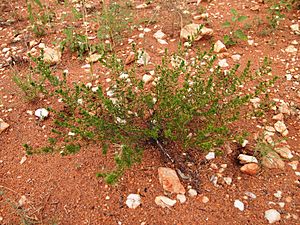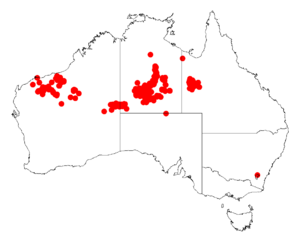Curry wattle facts for kids
Quick facts for kids Curry wattle |
|
|---|---|
 |
|
| Scientific classification | |
| Genus: |
Acacia
|
| Species: |
spondylophylla
|
 |
|
| Occurrence data from AVH | |
The Curry Wattle, also known as Acacia spondylophylla or Spine-leaf Wattle, is a special type of shrub. It grows in central and western Australia. This plant is famous for its leaves, which are arranged in circles around the stem and smell like curry!
Contents
What is the Curry Wattle Like?
This interesting shrub usually grows to be about 0.3 to 1 meter tall. Sometimes, it can even reach up to 2 meters high. It has a flat top and branches that spread out.
How to Identify the Curry Wattle?
The stems of the Curry Wattle are covered with soft, fine hairs. It has tiny leaf-like parts called stipules, which are about 1 to 1.5 millimeters long. Like many Acacia plants, it has phyllodes instead of true leaves. Phyllodes are flattened leaf stems that act like leaves.
Leaves and Flowers
The phyllodes of the Curry Wattle are arranged in groups of 8 to 14. They are mostly flat and can be straight or slightly curved at the tip. Each phyllode is about 6 to 10 millimeters long and less than 1 millimeter wide. They also have fine hairs and a faint line on the top surface.
The Curry Wattle usually blooms between May and August. It produces bright yellow flowers. These flowers grow in round clusters, with each cluster holding 25 to 40 yellow flowers.
Seed Pods and Seeds
After the flowers bloom, sticky, leathery seed pods start to form. These pods are long and can be straight or slightly curved. They are about 20 to 40 millimeters long and 6 to 8 millimeters wide. The pods have raised edges and contain seeds arranged across them. Each seed is about 3.5 to 4 millimeters long.
Where Does the Curry Wattle Grow?
The Curry Wattle is found in the dry, desert-like areas of central Australia. You can spot it in Western Australia, the Northern Territory, and Queensland.
Specific Locations in Australia
In Western Australia, it grows in the Pilbara region and the northern Goldfields. It often prefers to grow along creeks, on rocky hills, and in gullies. It likes stony or sandy soils, especially around ironstone.
The plant is quite common in the Hamersley Range in the Pilbara. From there, it spreads east, becoming more scattered past the Rawlinson Range in Western Australia. You can also find it in the MacDonnell Ranges and Musgrave Ranges in the Northern Territory. Further east, it reaches areas around Dajarra in Queensland.
How Was the Curry Wattle Named?
The Curry Wattle was first officially described by a botanist named Ferdinand von Mueller in 1874. He included its description in his work called Fragmenta Phytographiae Australiae.
Similar Plants
Sometimes, the Curry Wattle is confused with another plant called Acacia perryi. However, Acacia perryi has larger stipules and phyllodes, which helps tell them apart.
Can You Grow Curry Wattle?
Yes! The Curry Wattle naturally grows in stony and sandy soils. People have started growing it in gardens, especially in dry areas. This shrub is very good at handling drought conditions. It also grows back easily from its seeds, making it a tough and adaptable plant.

